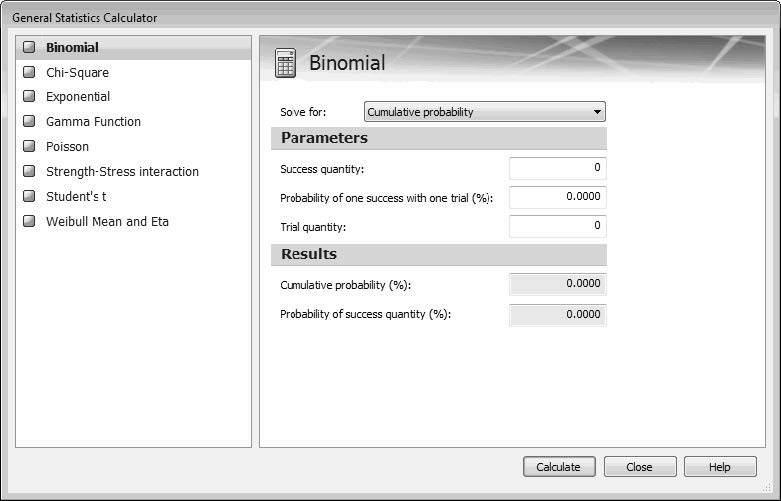General Statistics Calculator Overview
The General Statistics Calculator provides for running many different statistical calculations. To open this calculator, select > . The function selected in the navigation pane determines the options that area available.

The following table describes the functions that can be computed using the General Statistics Calculator. For Solve for, you select the value for which to solve. Under Parameters, you then supply the values required to perform this calculation. Once you click Calculate, the one or more results calculated from the supplied parameter values are shown under Result or Results.
Function | Description |
|---|---|
Binomial | Solves binomial problems, which have N trials. On each trial, an event either does or does not occur. The event can be a success or a failure, a defect or no defect, and so on. The five values of interest in a binomial problem are: • Cumulative probability (%) • Probability of one success with one trial (%) • Probability of success quantity (%) • Success quantity • Trial quantity Using this function, the General Statistics Calculator can solve for cumulative probability, probability of one success with one trial, or trial quantity. It also solves for the probability of success quantity (%). For more information, see Performing a Binomial Calculation. |
Chi-Square | Calculates the cumulative probability and the inverse of the cumulative probability for the Chi-Square distribution. For more information, see Performing a Chi-Square Calculation. For calculation information, see Chi Square Calculations. |
Exponential | Solves for reliability (R) or unreliability (1 - R) based on equipment characteristics. This relationship is mostly used for complex equipment with many possible failure mechanisms or for age-independent phenomena such as foreign object damage and accidents. Inputs needed are time of exposure (T) and either failure rate or MTBF (mean time between failures). The failure rate (f) and MTBF (MTBF = 1 / f) is updated if either is changed. The output is both reliability and unreliability (failure probability): R = exp(-Tf)). For more information, see Performing an Exponential Calculation. |
Gamma Function | Estimates the MTTF (mean time to failure) and standard deviation of the Weibull distribution. The gamma function is indicated by the Greek symbol Γ. For example, for the Weibull distribution, the ratio of MTTF to eta (η) is Γ(1 / β +1). For more information, see Performing a Gamma Function Calculation. |
Poisson | Defines a single parameter (the expected value or mean value) to use. The Poisson distribution is simple to use and easy to understand. The first term of the Poisson distribution, the probability of zero events, is the exponential distribution. It is identical to a Weibull distribution with a β equal to 1. The Poisson distribution is useful for calculating the number of random events that occurred in a continuum. It provides answers for problems such as defects per chip, accidents per year, power outages per year, lightning flashes per hour, flaws in a cable within a specified length, and red corpuscle blood count per square millimeter. For more information, see Performing a Poisson Calculation. |
Strength-Stress Interaction | Determines the probability of failure when failure distributions can be defined for the interacting of strength and load. For more information, see Performing a Strength-Stress Interaction Calculation. |
Student’s t | Determines how to adjust or improve the accuracy for small samples. The cumulative distribution function (CDF) output depends on the degrees of freedom and the t statistic value. For more information, see Performing a Student’s t Calculation. |
Weibull Mean and Eta | Solves for either the mean or eta (η) value. For a Weibull distribution, the η value is the characteristic life. You must provide the β (beta) value, which is the shape or slope parameter, and the other parameter value. For more information, see Performing a Weibull Mean or Eta Calculation. |